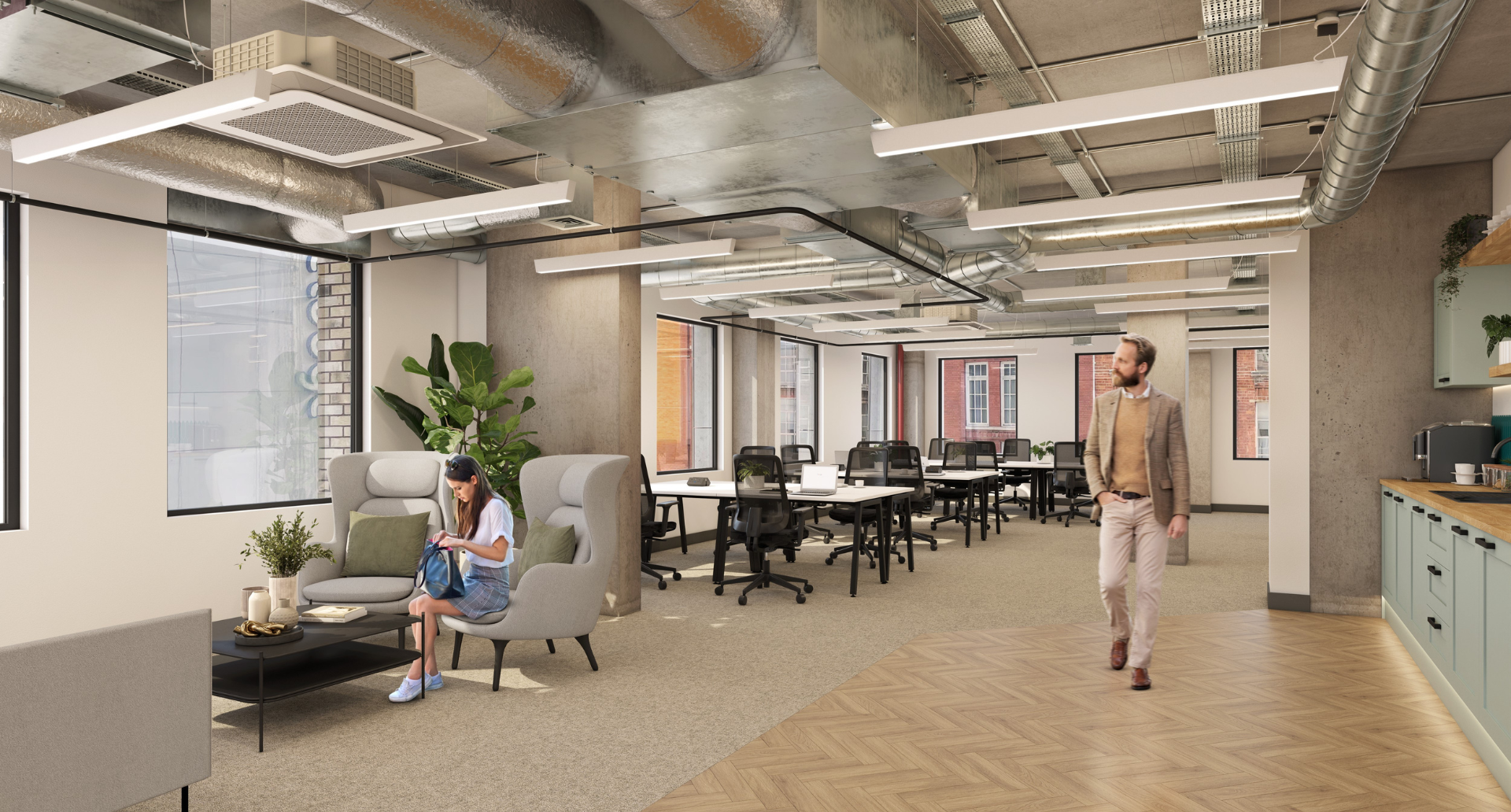
The growth in popularity of flexible working solutions post-pandemic presents businesses with an interesting choice. Thanks to the abundance of digital infrastructure that’s recently emerged, adopting a remote working policy is more viable than ever, but is it the right option?
As most businesses know, there are still very tangible advantages to working from an office space, at least some of the time. But it’s also clear to see that there’s strong demand from the workforce for more flexibility.
We’re here to analyse the benefits and drawbacks of working from home vs working from the office, so you can make an informed decision about which way of working is the best fit for your business.
What the statistics say about working from home vs the office
The Office for National Statistics (ONS) carried out a survey in June 2023 to determine where the UK workforce spent their time at work in a seven day measurement period. The results were split as follows between remote working and working from the office:
- 10% worked from home all the time
- 29% worked from home some of the time
- 49% didn’t work from home at all
- 12% didn’t work at all
A later study from TravelPerk, carried out in December 2023, found that 30% of companies in the UK were working fully from an office space. But only 8% were working entirely remotely.
Over 40% of companies were using a hybrid workplace strategy, with employees splitting their time between a flexible workplace and their home. That makes hybrid working the most popular option by a decent margin, with full-time office working coming in second place.
Data from the Chartered Institute of Personnel and Development (CIPD) hints at why that might be. In a survey from 2023, they found that there’d been a 40% increase in employees requesting flexible working following the pandemic. And a growing number of employers believed it was important to offer it, with 66% saying it was a key way to attract staff.
To really understand which method of working is best for your business, though, it’s important to think about the pros and cons of each.
Pros and cons of remote working
Remote working hasn’t become so popular so quickly for no reason – there are lots of reported benefits for companies that adopt it, including:
- Cost savings: Remote working reduces the need for an office space, which is generally a significant cost. That means your business could save money by allowing all employees to work from home, even if it’s only for a day a week.
- Increased productivity: Working from home is a great fit for the way some people like to work, which can increase their productivity. The ONS study mentioned earlier found that 53% of home workers felt less distracted and 52% completed their work more quickly, for example. On the other hand, though, not everybody has the space to work from home comfortably.
- Better access to talent: Adopting a fully remote policy opens your business up to the global talent pool, since you’re no longer restricted by hiring from within a certain area near your office.
However, remote working doesn’t only present positives. There are plenty of drawbacks to the model, too, including:
- Communication challenges: Even with all the digital communication technology in the world, it can still be hard to avoid communication barriers when your employees are distributed across a wide area, potentially even working at different times. 48% of remote workers in the ONS study said it was harder to work with others.
- Potential for isolation: Working remotely can be isolating, with one study showing that there was a 67% increase in loneliness measured in people working remotely full-time versus in an office.
- Loss of company culture: The office presents lots of social benefits that are hard to measure but can be sorely missed when they’re gone. This includes the building of a solid company culture, and the opportunities employees have to meet and build relationships with new people.
Pros and cons of working from the office
Working from the office was the status quo pre-pandemic, but that doesn’t mean that its benefits are outdated. The pros of the traditional approach include:
- Improved collaboration: Working in a central office space puts different teams in your business in touching distance of each other, which makes it easier for them to collaborate or generate new exciting ideas together. In fact, communication in general is just easier when everybody is in the same place.
- Better operational security: In an office, you can have complete confidence in a secure network that protects your business’s data, as opposed to the remote-first approach where your data is only as secure as the weakest link. This is particularly important for businesses that work in areas where confidentiality is key.
- Stronger company culture: Employees that work together in the same space have more opportunities to grow together, forging a stronger company culture that can benefit businesses in diverse ways.
But, as with remote working, working from the office also has some drawbacks, including:
- Higher overhead costs: Working from an office requires that you have an office, which presents a cost. While the benefits of having an office might outweigh that cost, it’s still an expense that isn’t presented by remote working.
- Long commutes: Employees travelling to hard-to-reach workplaces from far away can be faced with long, stressful commutes that eat into their work-life balance and make it harder for them to be productive during their time in the office.
- Limited flexibility: Working in the office leaves little room for flexibility in terms of working arrangements, as full-time office-based businesses generally won’t have infrastructure set up to allow employees to take a day from home. This can increase absenteeism when employees are sick or have family obligations, for example.
Choosing the best way of working for your business
As you’d expect, there’s no clear way to crown one single method of working as ‘the best’, given that both remote working and working from the office have their own unique pros and cons.
Choosing the best way of working for your business requires some serious thought. This is best approached by creating a proper workplace strategy, in which you figure out what you’re looking to achieve and systematically determine which method of working will help you achieve it.
It’s also important to remember that you don’t need to stick to a single method. Hybrid working is an endlessly configurable middle option that can help you to avoid the most extreme disadvantages of fully-remote or fully-office based working.
You could, for example, choose to have a centrally-located serviced office that employees can choose to work from whenever they want. Alternatively, you could mandate a certain number of days in the office per week for each employee, allowing you to save money by choosing a smaller workplace that’s used by specific teams on a rotating basis.
You could even embrace coworking, giving employees a certain allowance for hot desk usage in a flexible workplace every month and allowing them to work from home the rest of the time.
Because flexibility is such a big priority for so many businesses, there’s plenty of choice out there when it comes to flexible workplaces. That means you have a lot of freedom to design a solution that suits your needs perfectly.
Flexible workplaces like the 40+ locations in The Boutique Collection are ideally suited to businesses trying out new ways of working, with flexible contracts that allow you to scale your space up or down as your needs change.
All of our workplaces are also fully-serviced, which means you don’t have to worry about cleaning or maintenance, and contain diverse amenities including meeting rooms. And we prioritise great locations that are easy to reach via public transport, reducing the burden for commuters.
If you’re considering adopting a hybrid working strategy, moving back to an office after a period of remote working, or changing your workplace arrangement in any other way, get in touch with us to find out more about how our workplaces can fit your plans.
Related Posts

Dec 12 2022
Holborn Town Hall: Flexible offices and coworking in a historic Holborn building
Holborn is one of central London’s most exciting districts, and it’s never been a more compelling option for businesses seeking the perfect office location. It’s...
Read more
Mar 25 2024
A guide to building a hybrid workplace strategy
Hybrid working is growing in popularity as a replacement for an always-in-the-office approach, with benefits for both employers and employees. But rolling...
Read more
May 30 2022
124 Wigmore Street: A new office space option in Marylebone
Marylebone is a wonderful area of London, full of cultural delights, well connected with major underground and National Rail services, and flanked on both sides by beautiful...
Read more



